
The Bristol Aeroplane Company, originally the British and Colonial Aeroplane Company, was both one of the first and one of the most important British aviation companies, designing and manufacturing both airframes and aircraft engines. Notable aircraft produced by the company include the 'Boxkite', the Bristol Fighter, the Bulldog, the Blenheim, the Beaufighter, and the Britannia, and much of the preliminary work which led to Concorde was carried out by the company. In 1956 its major operations were split into Bristol Aircraft and Bristol Aero Engines. In 1959, Bristol Aircraft merged with several major British aircraft companies to form the British Aircraft Corporation (BAC) and Bristol Aero Engines merged with Armstrong Siddeley to form Bristol Siddeley.

AC Cars, originally incorporated as Auto Carriers Ltd., is a British specialist automobile manufacturer and one of the oldest independent car makers founded in Britain. As a result of bad financial conditions over the years, the company was renamed or liquidated many times until its present form. In 2022, the new corporate structure began the production of new AC Cobra models, with a slightly modified structure to adapt it to modern safety and technology requirements and obtain the European road homologation certificate.

Bristol Cars was a British Manufacturer of hand-built luxury cars headquartered in Bristol, England. It was formed from the car division of the Bristol Aeroplane Company after the Second World War and later became independent as Bristol Cars Limited. After being placed in receivership and being taken over in 2011, it entered liquidation in February 2020.
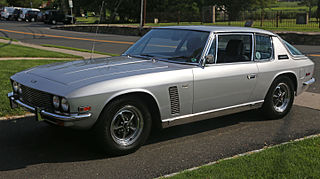
The Jensen Interceptor is a grand touring car which was hand-built at the Kelvin Way Factory in West Bromwich, near Birmingham in England, by Jensen Motors between 1966 and 1976. The Interceptor name had been used previously by Jensen for the Jensen Interceptor made between 1950 and 1957 at the Carters Green factory. Jensen had extensively used glass-reinforced plastic for the fabrication of body panels in the preceding two decades, but the new Interceptor was a return to a steel body-shell. The body was designed by an outside firm, Carrozzeria Touring of Italy, rather than the in-house staff. The early bodies were built in Italy by Vignale, before Jensen took production in house, making some subtle body modifications.

The Plymouth Fury is a model of automobile that was produced by Plymouth from 1955 until 1989. It was introduced for the 1956 model year as a sub-series of the Plymouth Belvedere, becoming a separate series one level above the contemporary Belvedere for 1959. The Fury was a full-size car from 1959 until 1961, then a mid-size car from 1962 until 1964, again, a full-size car from 1965 through 1974, and again, a mid-size car from 1975 through 1978. From 1975 until 1977, the Fury was sold alongside the full-size Plymouth Gran Fury. In 1978, the B-body Fury was the largest Plymouth, and by 1979, there was no large Plymouth. This product gap was filled in 1980 with the R-body Gran Fury, followed by the M-body Fury in 1982. Production of the last V8, RWD Plymouth Fury ended at the Kenosha Main assembly plant in Kenosha, WI, on December 23, 1988. Unlike its sibling brand, Dodge, Plymouth would not live to see the resurgence of the large, V8/RWD sedan.

The Chrysler Saratoga is an automobile built by Chrysler. The nameplate was used from 1939 to 1952 and from 1957 to 1960 in the U.S. market, in Canada through 1965, and in Europe from 1989 to 1995. In the beginning, it was introduced as a sport luxury model, using the Straight Eight engine from the Chrysler New Yorker which was more formal, and the Imperial which had graduated to special order limousine.
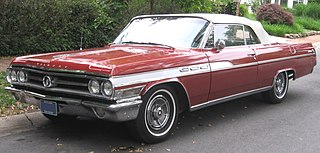
The Buick Wildcat is a full-size car that was produced by Buick from the 1963 to 1970 model years. Taking its name from a series of 1950s Buick concept cars, the Wildcat replaced the Invicta within the "junior" B-body Buick sedan range. Serving as the higher-performance full-size Buick, the Wildcat was slotted between the LeSabre and the larger C-body Electra.

The Lancia Flavia is an executive car produced by Lancia in Italy from 1961 to 1971. Production continued as the Lancia 2000 from 1971 to 1975.

The Chrysler Hemi engines, known by the trademark Hemi or HEMI, are a series of American V8 gasoline engines built by Chrysler with overhead valve hemispherical combustion chambers. Three different types of Hemi engines have been built by Chrysler for automobiles: the first from 1951 to 1958, the second from 1964 to 1971, and the third from 2003 to 2024. Although Chrysler is most identified with the use of "Hemi" as a marketing term, many other auto manufacturers have incorporated similar designs. The engine block and cylinder heads were cast and manufactured at Indianapolis Foundry.

The Aston Martin Virage is an automobile produced by British luxury automobile manufacturer Aston Martin as a replacement for its V8 models. Introduced at the Birmingham Motor Show in 1988, it was joined by the high-performance Vantage in 1993, after which the name of the base model was changed to V8 Coupe in 1996.
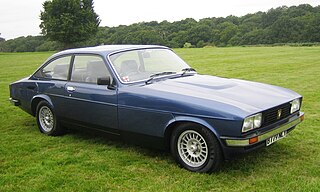
The Bristol Type 603 is a car that was launched in 1976 by British manufacturer Bristol Cars to replace the 411. With the 603 – introduced along with the Zagato-built 412 – the Bristol car underwent its first major facelift since the introduction of the 406 in the late 1950s. The design was to last until the marque's demise in 2011. Bristol's chief designer Dudley Hobbs strove to make the car more spacious and aerodynamic, while also using flatter body panels that would be easier to hammer.
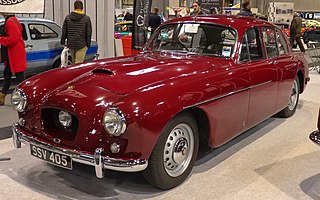
The Bristol 404 and Bristol 405 are British luxury cars which were manufactured by the Bristol Aeroplane Company. The 404 was manufactured from 1953 to 1958, and the 405 from 1955 to 1958. The models were successors to the Bristol 403. The 404 was a two-seat coupé and the 405 was available as a four-seat, four-door saloon and as a four-seat, two-door drophead coupé.
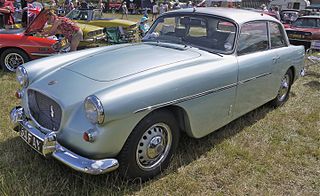
The Bristol 406 was a luxury car produced between 1958 and 1961 by British manufacturer Bristol Aeroplane Co. Their cars were constructed to very high engineering standards and were intended to be long-lasting to justify their very high price. Buyers might arrange considerable changes to the specification of their own particular vehicle. Bristol Aeroplane's car division later became Bristol Cars.

The Bristol 407 was a sports tourer car produced by British manufacturer Bristol Cars between 1961 and 1963. It was the first Bristol model to be made by the company after separation from the Bristol Aeroplane Company, which had built all previous Bristol models. Outwardly it resembled the 406, on which it was based, and which had been produced between 1958 and 1961.

The Bristol 408 is a British luxury car made by Bristol Cars between 1963 and 1966. Unusually for Bristol, a slightly revised version was launched during the middle of the model's production run in 1965 and known as the 408 Mark II.

The Bristol 409 was the third series of cars from British manufacturer Bristol Cars powered by Chrysler V8 engines. It was actually introduced before the older Bristol 408 went out of production and only gradually supplanted that model after a year.
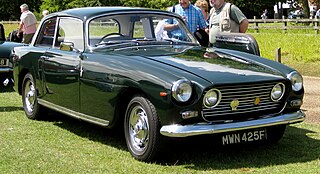
The Bristol 410 was the fourth series of Chrysler V8-engined models from British manufacturer Bristol Cars. It was the last Bristol to use the 5.2-litre (318 cubic-inch) engine originally found in the Bristol 407.
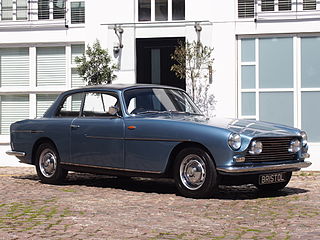
The Bristol 411 is an automobile which was built by the British manufacturer Bristol Cars from 1969 to 1976. It was the fifth series of Chrysler-V8 engined Bristol models. The car was rated highly for its comfort, performance and handling by contemporary reviewers.

The Viper engine is a high-performance naturally-aspirated pushrod 2 valves-per-cylinder 90° V10 engine designed by Chrysler but with aluminum block castings designed by Lamborghini for use in the Dodge Viper. Despite its large displacement, it is based on the Chrysler LA V8.

The Bristol 406 Zagato is a British-Italian sports car that combines the technology of the Bristol 406 Saloon with a body designed and built by Zagato. This special model, often considered eccentric, was commissioned by Bristol dealer Tony Crook and was produced in very limited quantities. It is known for being lighter, smaller, and faster than the factory-bodied base car. In addition, some older Bristol chassis also subsequently received similar Zagato bodies. Today, the 406 Zagato is considered one of the most expensive classics within the brand’s lineup.






















